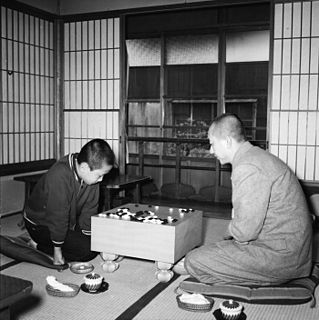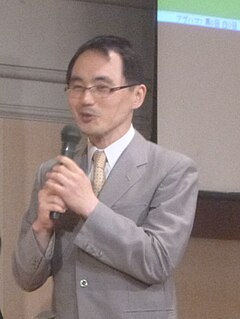This article needs to be updated.(November 2014) |
The 36th Meijin began league play on 2 December 2010 and concluded in October 2011. The defending champion was Iyama Yuta. [1]
This article needs to be updated.(November 2014) |
The 36th Meijin began league play on 2 December 2010 and concluded in October 2011. The defending champion was Iyama Yuta. [1]
The preliminary tournament started on 5 August 2010. Takao Shinji, Cho U, Yuki Satoshi, Sakai Hideyuki, Mizokami Tomochika, and Cho Chikun retained their places in the league from the 35th Meijin. These players were joined by the winners of the preliminary tournament: Yamashita Keigo, Hane Naoki, and Rin Kanketsu. [1]
| Quarter-finals | Semi-finals | Final | ||||||||
| 5 August | ||||||||||
| Yamashita Keigo | 1 | |||||||||
| 23 September | ||||||||||
| Yoda Norimoto | 0 | |||||||||
| Yamashita Keigo | 1 | |||||||||
| 26 August | ||||||||||
| Han Zenki | 0 | |||||||||
| Han Zenki | 1 | |||||||||
| 21 October | ||||||||||
| Mimura Tomoyasu | 0 | |||||||||
| Yamashita Keigo | 1 | |||||||||
| 2 September | ||||||||||
| Seto Taiki | 0 | |||||||||
| Seto Taiki | 1 | |||||||||
| 23 September | ||||||||||
| Fujii Shuya | 0 | |||||||||
| Seto Taiki | 1 | |||||||||
| 9 September | ||||||||||
| Ogata Masaki | 0 | |||||||||
| Kono Rin | 0 | |||||||||
| Ogata Masaki | 1 | |||||||||
| Quarter-finals | Semi-finals | Final | ||||||||
| 19 August | ||||||||||
| Hane Naoki | 1 | |||||||||
| 23 September | ||||||||||
| Tsuruyama Atsushi | 0 | |||||||||
| Hane Naoki | 1 | |||||||||
| 2 September | ||||||||||
| Murakawa Daisuke | 0 | |||||||||
| Murakawa Daisuke | 1 | |||||||||
| 28 October | ||||||||||
| Aragaki Takeshi | 0 | |||||||||
| Hane Naoki | 1 | |||||||||
| 2 September | ||||||||||
| Yamada Kimio | 0 | |||||||||
| Kobayashi Satoru | 1 | |||||||||
| 30 September | ||||||||||
| Yukawa Mitsuhisa | 0 | |||||||||
| Kobayashi Satoru | 0 | |||||||||
| 9 September | ||||||||||
| Yamada Kimio | 0 | |||||||||
| Kataoka Satoshi | 0 | |||||||||
| Yamada Kimio | 1 | |||||||||
| Quarter-finals | Semi-finals | Final | ||||||||
| 19 August | ||||||||||
| Matsuoka Hideki | 0 | |||||||||
| 30 September | ||||||||||
| Kono Takashi | 1 | |||||||||
| Kono Takashi | 0 | |||||||||
| 9 September | ||||||||||
| Rin Kanketsu | 1 | |||||||||
| Ryu Shikun | 0 | |||||||||
| 28 October | ||||||||||
| Rin Kanketsu | 1 | |||||||||
| Rin Kanketsu | 1 | |||||||||
| 5 August | ||||||||||
| O Meien | 0 | |||||||||
| Suzuki Shinji | 0 | |||||||||
| 7 October | ||||||||||
| Goto Shungo | 1 | |||||||||
| Goto Shungo | 0 | |||||||||
| 26 August | ||||||||||
| O Meien | 1 | |||||||||
| Sakakibara Masaaki | 0 | |||||||||
| O Meien | 1 | |||||||||
League play commenced on 2 December 2010 after the preliminaries. The winner of the league was Keigo Yamashita. Hideyuki Sakai, Cho Chikun, and Rin Kanketsu were eliminated from the league. [1]
| Player | T.S. | C.U. | Y.S. | S.H. | M.T. | C.C. | Y.K. | H.N. | R.K. | Record | Notes |
|---|---|---|---|---|---|---|---|---|---|---|---|
| Shinji Takao | – | W+4.5 | X | W+R | B+R | W+0.5 | X | X | B+R | 5–3 | |
| Cho U | X | – | W+0.5 | X | X | B+4.5 | W+R | B+R | W+4.5 | 5–3 | |
| Satoshi Yuki | W+0.5 | X | – | W+1.5 | B+R | W+R | X | X | B+R | 5–3 | |
| Hideyuki Sakai | X | W+0.5 | X | – | W+R | X | X | X | X | 2–6 | Eliminated |
| Tomochika Mizokami | X | B+2.5 | X | X | – | W+R | X | 1.5 | X | 3–5 | |
| Cho Chikun | X | X | X | W+R | X | – | X | X | X | 1–7 | Eliminated |
| Keigo Yamashita | W+3.5 | – | W+R | B+R | W+4.5 | B+R | – | X | B+R | 6–2 | League winner |
| Naoki Hane | B+R | X | B+R | W+0.5 | X | W+R | B+6.5 | – | W+0.5 | 6–2 | |
| Rin Kanketsu | X | X | X | B+4.5 | W+0.5 | B+R | X | X | – | 3–5 | Eliminated |
| Iyama Yuta Meijin | B+R | W+R | 2 | |||||
| Dowa Yamashita Honinbo | B+5.5 | B+R | W+R | W+3.5 | 4 |

Cho Hunhyun is a South Korean 9-dan professional Go player. Considered one of the greatest players of all-time, Cho reached professional level in Korea in 1962. Since then, Cho has amassed 150 professional titles, more than any player in the world. He thrice held all of the open tournaments in Korea in 1980, 1982 and 1986. Cho has also won 11 international titles, third most in the world behind Lee Chang-ho (21) and Lee Sedol (18). He reached 1,000 career wins in 1995.

Cho Chikun25th HoninboHonorary Meijin is a professional South Korean Go player and a nephew of Cho Namchul. His total title tally of 75 titles is the most in the history of the Japanese Nihon Ki-in. Cho is the first player to hold the top three titles—Kisei, Meijin, and Honinbo—simultaneously which he did for three years in a row. Cho is the first in history to win all of the "Top 7" titles in Japan which he achieved by winning the Oza in 1994. Cho U in 2011 and Iyama Yuta in 2013 would duplicate this feat, both by winning the Kisei. He is also one of the 'Six Supers' Japanese players that were most celebrated in the late twentieth century, along with Rin Kaiho, Otake Hideo, Takemiya Masaki, Kato Masao and his classmate and arch-rival Kobayashi Koichi.

Rin Kaihō or Lin Haifeng is a professional Taiwanese Go player who made his name in Japan. He is, along with Cho Chikun, Kobayashi Koichi, Otake Hideo, Takemiya Masaki and Kato Masao, considered one of the 'Six Supers' that dominated Japanese Go world in the last three decades of the twentieth century.
Cho U is a Taiwanese professional Go player. He currently ranks 6th in the most titles won by a Japanese professional; his NEC Cup win in 2011 put him past his teacher Rin Kaiho and Norimoto Yoda. Cho is the first player in history to have held five of the top seven major titles simultaneously with Iyama Yuta being the second. Cho U, Naoki Hane, Keigo Yamashita and Shinji Takao make up the group of players in Japan called the "Four Heavenly Kings". His wife is one of Japan's best female go professionals, Izumi Kobayashi, the great Kitani's granddaughter and daughter of Kobayashi Koichi.
Yuta Iyama Kisei, Honinbo, Meijin is a Japanese professional Go player. In April 2016, he became the first player in Japanese history to hold all seven major titles simultaneously. In January 2018, Iyama became the first professional Go player to be awarded Japan's People's Honour Award.
Professional Go players in Japan are given the title of "Honorary" title holder if they hold a title for a straight five or more years. Below is a list of the honorary title holders and which title they are honored for.
Satoshi Yuki is a Japanese professional Go player.
The 1st Kisei was the birth of a new Go tournament. Since this was the first year of the tournament, there was no set challenger or holder. From the 2nd edition on, there has been a playoff between challengers. At the time, it was the highest paying tournament there had ever been, and would be until the creation of the Ing Cup. Fujisawa Hideyuki's win would mark the beginning of a six-year defense of the Kisei title from 1977 to 1982.
The 31st Kisei is being held from May 2006 to March 22, 2007. The following players earned spots through not being eliminated in the group stage: Satoshi Yuki (5-0), Tomoyasu Mimura (3-2), Kato Atsushi (3-2), Kobayashi Satoru (3-2), Komatsu Hideki (3-2), Norimoto Yoda (2-3), and O Rissei (2-3). Cho U, Kunihisa Honda, O Meien, and Toshiya Imamura were eliminated from group play and had to earn a spot through preliminary stages. The players to have qualified through preliminary tournaments are Cho U, Kunihisa Honda, Cho Chikun, and Toshiya Imamura. Naoki Hane, the loser of the 30th Kisei takes the place of holder Keigo Yamashita in the group stage. Players who end with the two lowest records in the each league are eliminated from automatic berth into the next tournament while the 3 other players who were not eliminated or had the top record are given a place in the following years groups.

Hideyuki Sakai is a professional Go player.
The 11th LG Cup professional Go tournament was won by Zhou Junxun. It featured:
The 30th Kisei was held from May 2005 to February 22, 2006. The players to have qualified through preliminary tournaments are Toshiya Imamura, Atsushi Kato, Hideki Komatsu, and Kunihisa Honda. The players to have returned from the previous year are Satoshi Yuki, Norimoto Yoda, Cho U, Tomoyasu Mimura, Keigo Yamashita, O Rissei, O Meien, and Kobayashi Satoru. Players who end with the two lowest records in the each league are eliminated from automatic berth into the next tournament.
The 45th Judan was held from May 11, 2006 to April 25, 2007. The current sponsor is Sankei Newspapers. The holder is Cho Chikun, and the challenger is Keigo Yamashita for the second time in-a-row. Hideki Komatsu, Norimoto Yoda, Kimio Yamada, Hideo Otake, Koichi Kobayashi, Kim Shushun, Naoki Hane, and Takeshi Sakai qualified through preliminary tournaments. The rest of the players were given spots automatically.
The 24th Fujitsu Cup featured 32 players.
The 35th Kisei began league play on 3 June 2010 and concluded with Cho U defending his title in six games over challenger Iyama Yuta on 11 March 2011.
The 66th Honinbo began league play on 7 October 2010 and completed on July 21, 2011. Title holder Yamashita Keigo retained his title over challenger Hane Naoki by a score of 4-3. Yamashita Keigo won the first three games, Hane Naoki the next three, and Yamashita Keigo the final game.
The 18th Agon Cup began on 21 April 2011-1 October 2011. Two Korean amateur players were invited to the preliminaries, with both qualifying. Ha Sungbong defeated professionals Yanigasawa Satoshi and Furuya Yutaka. Kim Sungjin defeated 25th Honinbo and Japan's top title holder Cho Chikun. He also defeated Kato Atsushi. In the main tournament, he was knocked out by Iyama Yuta Meijin in the first round. Iyama Yuta came out as the winner. He beat Yamashita Keigo at the final. The winner's prize was ¥10,000,000.
The 1st Igo Masters Cup began on 24 February and ended on 23 July 2011. Eleven players participated: Kobayashi Koichi, Kudo Norio, Rin Kaiho, Kataoka Satoshi, Hane Yasumasa, Ishida Yoshio, Takemiya Masaki, Cho Chikun, O Rissei, Kobayashi Satoru, Otake Hideo.